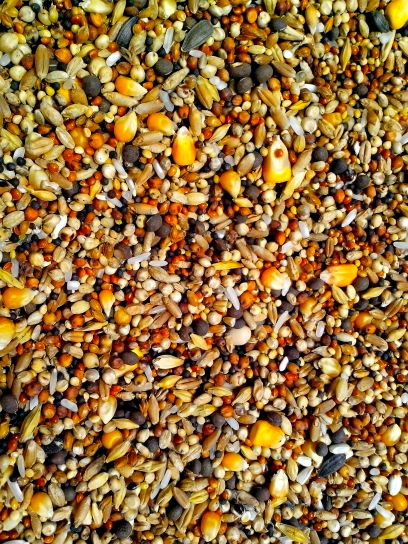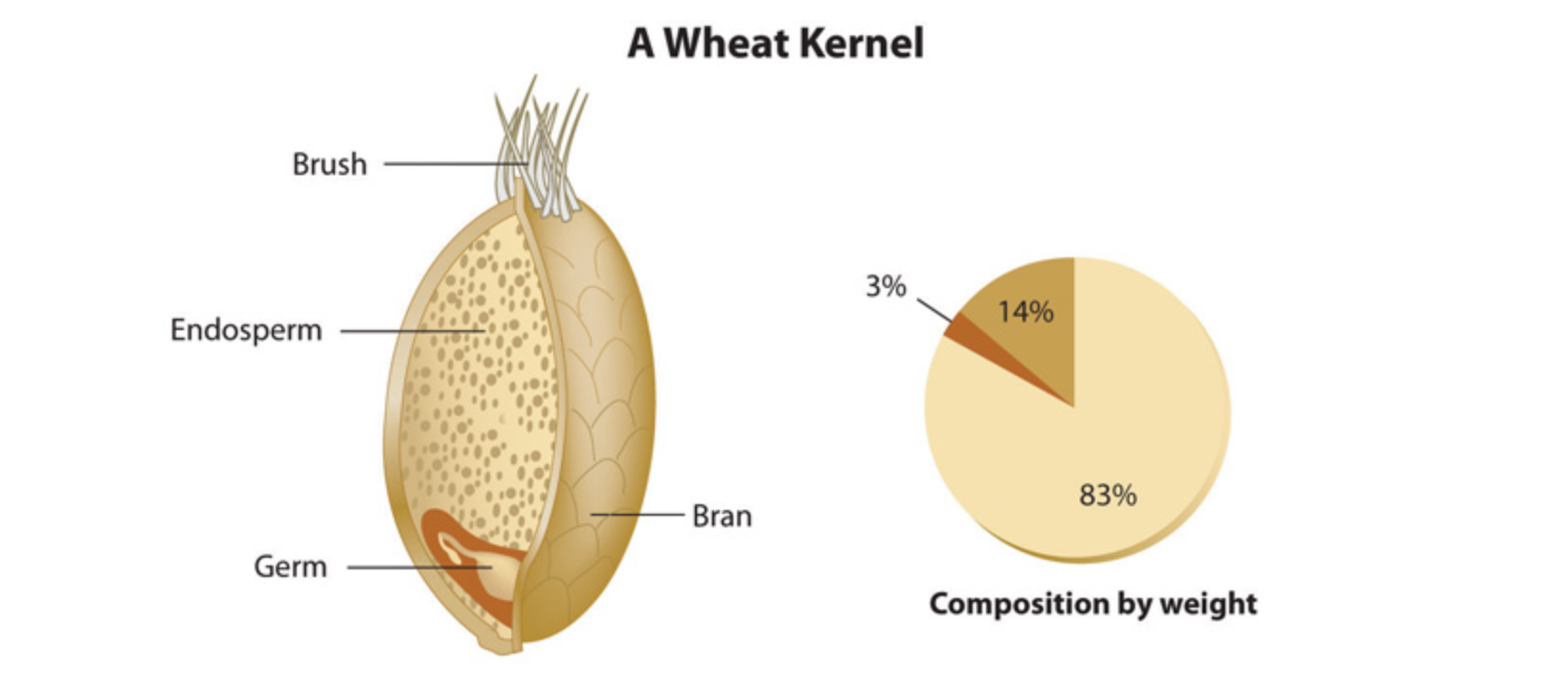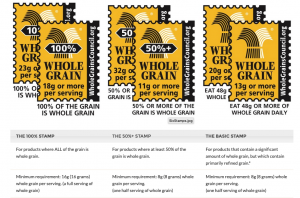5.1 – Introduction to Carbohydrates and Whole Grains
You likely eat grains every day—cereal, a sandwich, pasta, or your favorite rice dish. Whole grains are vital to a healthful diet. In addition to fiber, whole grains offer other slow-releasing carbohydrates, antioxidants, vitamins, and minerals, all of which are needed for good health. Maybe you are on a lower-calorie diet and have been told to limit or restrict your carbohydrate intake. How much is too much and which carbohydrates are better for you? Can you promote a healthy weight with a balanced intake of whole grains? Before we answer these questions, let’s examine in brief the history of grain.
In ancient times whole grains were cracked open using quern stones that required hours of hand labor. As technology slowly advanced, the quern stone was modified into the millstone. It wasn’t until the advent of water wheels that human labor to produce grains was reduced. About 2,500 years ago the Romans started milling flour by turning one millstone wheel against another that did not move. The turning was done by animals, slaves, and later by waterwheels. The process of milling breaks the hard outer bran coat of the wheat seeds. The bran and germ, which contain the majority of fiber, vitamins, and minerals, are removed by sifting. In the earliest days, the whitest flour was chosen to make bread for the wealthy, and the coarsest was given to the poor. One’s economic status was depicted by the color of the bread they ate. Wheat was the grain of choice for many cultures, as it not only produced white flour but also contained gluten which gives wheat bread its elasticity and lightness in texture. The word “flour” comes from a French word meaning “blossom” and is metaphoric for the finest part of the meal. Bakers highly prized their art and it was kept from the masses. In fact, the baker’s mark was one of the first trademarks.
Figure 5.1.1: Image of grains. The 2015 Dietary Guidelines recommend that half of all grains in your diet come from whole grains. What percentage of your diet is whole grain?


| Wheat Kernel Aspect | Carb/g | Protein/g | Fat/g | Fiber/g | Iron(% Daily Requirement) | Other vitamins and nutrients |
|---|---|---|---|---|---|---|
| Bran | 63 | 16 | 3 | 43 | 59 | vitamin Bs |
| Endosperm | 79 | 7 | 0 | 4 | 7 | None |
| Germ | 52 | 23 | 10 | 14 | 35 | vitamin Bs omega-3/6 lipids |
In the early nineteenth century several diseases stemming from vitamin and mineral deficiencies, such as pellagra (niacin, B3), beriberi (thiamine, B1), and anemia (iron), plagued many inhabitants of the nation. One of the first public health campaigns was to improve the health of Americans by enriching flour, a dietary staple. The B vitamins, niacin, thiamine, riboflavin, and folate were added along with iron to combat dietary deficiencies and proved a successful strategy to improve public health. However, enriched flour contains only 6 percent or less of the recommended daily intake of the vitamins and minerals it “replaces.” Overwhelming scientific evidence now shows that diets containing high amounts of whole grains rather than refined white flour decrease weight gain and the risk for many chronic diseases, including certain types of cancer and diabetes. Whole grains contain a whole nutrient package that is not replaced by enriched flour. Consumers are becoming more aware of the many health benefits of whole grains. However, the food industry has created a puzzle for consumers in determining if a product is made from 100 percent whole grains. “Whole wheat” does not always mean the product is made with 100 percent whole grains, and brown bread is not always healthier than white as the color may come from added caramel coloring. The Food and Drug Administration (FDA) has provided the food industry with specifics on how to label whole-grain foods—to label them as made from 100 percent whole grains. The best method to ensure the product is made from 100 percent whole grains is to check the ingredient list. One-hundred percent whole-grain products list whole grains or whole-wheat flour most often as the first ingredient and do not contain wheat flour, white flour, yellow corn flour, semolina flour, degerminated flour, or durum flour. In America, whole-grain choices are improving, but progress still needs to be made on reducing the added sugar content of many industrially prepared bread, assuring added fiber comes from good sources, eliminating ambiguous labels and claims on packaging, and reducing the costs of whole-grain bread, which still exceed that of white bread.
The Oldways Whole Grain Council developed the whole grain stamp to help consumers identify products that contain whole grains. In order to obtain the 100% stamp, all of the grains in the product must be whole grain and must contain at a minimum, 16 grams of whole grain flour (one serving of whole-grain). For more information on whole grains, visit the whole grains council website.

Figure 5.1.2 The Whole Grain Stamp.
Oldways Whole Grain Council website
Long Description:
The image displays three whole grain stamps used on product packaging to indicate whole grain content. Each stamp is designed like a serrated-edge rectangular seal with a bold yellow background and black text, accompanied by a stylized grain image. The first stamp on the left displays “100% WHOLE GRAIN 23g or more per serving” and notes that “100% OF THE GRAIN IS WHOLE GRAIN.” The second, center stamp reads “50%+ WHOLE GRAIN 32g per serving” with the note “50% OR MORE OF THE GRAIN IS WHOLE GRAIN.” The third, on the right, states “WHOLE GRAIN 20g or more per serving,” followed by “EAT 48g OR MORE OF WHOLE GRAIN DAILY.” Below the stamps is a comparison table detailing the usage of each stamp: “THE 100% STAMP,” “THE 50%+ STAMP,” and “THE BASIC STAMP.” Each section describes the products associated with each stamp and notes the minimum whole grain requirements per serving.
You Decide
What 100 percent whole-grain products can you include in your diet to improve health, prevent disease, and be tastefully satisfied?
As you read on, you will learn the different types of carbohydrates, their essential roles in the body, the potential health consequences, and benefits of diets rich in particular carbohydrates, and the many foods available that are rich in carbohydrates as well as nutritious and satisfying. After reading this chapter, you will be better equipped to decide the best way to get your nutritional punch from various carbohydrates in your diet.
“If thou tastest a crust of bread, thou tastest all the stars and all the heavens.”
Robert Browning, English poet, and playwright (May 1812–December 1889)

